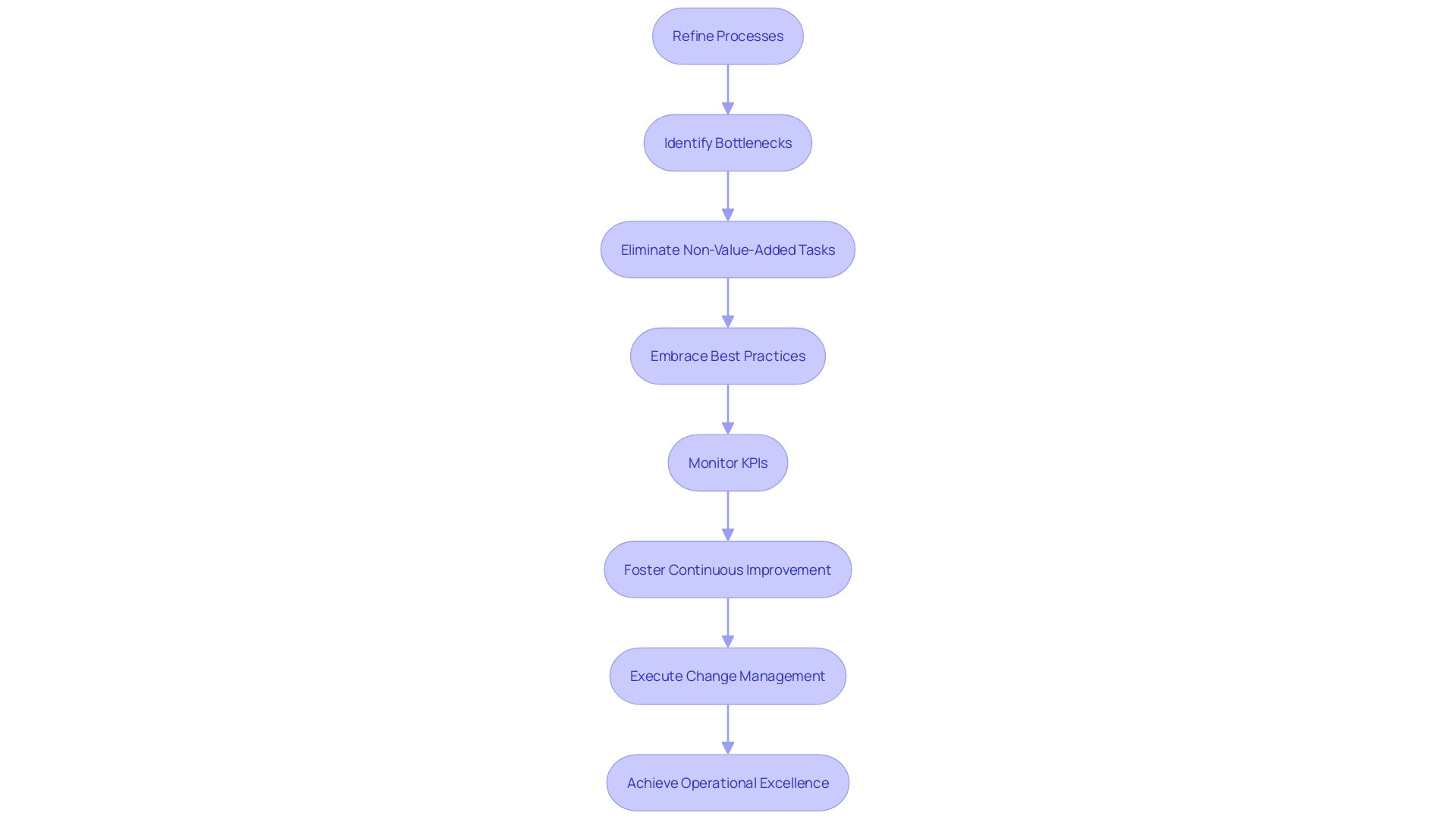Introduction
To orchestrate a successful business turnaround, a meticulous evaluation of the enterprise's current circumstances is paramount. This involves a comprehensive analysis, including financial scrutiny, pinpointing critical challenges, and grasping the core reasons behind any setbacks. Annual business reviews serve as strategic planning tools, ensuring alignment with long-term objectives.
Embracing transformation as a continuous process and removing barriers to technology adoption are essential in today's dynamic business environment. Stakeholder engagement plays a vital role, fostering a shared commitment to transformation and aligning with global trends. A clear vision and dynamic strategy are the bedrock of any successful turnaround, involving envisioning the company's future and meticulously plotting the path to get there.
Financial restructuring and cost management are pivotal in reversing a company's fortunes, while operational excellence focuses on refining processes and achieving greater efficiency. Market analysis and customer focus are crucial in identifying and catering to customer needs, securing a competitive advantage. Leadership drives cultural transformation, shaping a work culture that values accountability, innovation, and excellence.
Employee engagement and communication are strategic imperatives in business turnarounds, positively impacting productivity and success. Monitoring business performance and swiftly adapting to new data are critical in maintaining a successful turnaround strategy. Lastly, restoring confidence amidst adversity involves understanding market demands, addressing psychological aftermath, and taking decisive action, even amidst uncertainty.
By following these key steps, businesses can revitalize and steer themselves towards growth and profitability.
Assessment and Diagnosis
To navigate a successful business turnaround, a meticulous evaluation of the enterprise's current circumstances is paramount. A compelling example of this approach in action can be seen in the hospitality industry, where Strategic Solution Partners (SSP) pioneered operational enhancements and strategic planning to revitalize a central city hotel's food and beverage sales. This methodology echoes the importance of a comprehensive analysis, including financial scrutiny, pinpointing critical challenges, and grasping the core reasons behind any setbacks.
The annual business review is a fundamental exercise in this process, focusing on goal assessment and market position analysis. It's a strategic planning tool that serves as a periodic checkpoint, ensuring alignment with long-term objectives. By dissecting business operations, client feedback, employee performance, and market trends, a robust strategy for the forthcoming year can be crafted, sharpening the team's focus.
Embracing transformation as a continuous process, as advocated by Kurt Lewin's unfreeze-change-refreeze model, is also critical. Yet, in today's dynamic business environment, the refreeze phase has become obsolete. Companies must stay in a perpetual state of transformation, continuously adjusting to new developments and challenges.
Moreover, Matt O'Donovan, CEO of SPARK TSL, emphasizes the importance of removing barriers to technology adoption in the NHS, which is pertinent to any sector. The goal to make hospital trusts leaders in digital transformation underlines the need for innovation and agility in business strategies.
In summary, a successful turnaround strategy involves a thorough assessment of the current situation, strategic planning through annual reviews, continuous transformation, and embracing technological advancements. These steps, supported by real-world success stories and expert insights, offer a solid foundation for revitalizing a business and steering it back to a path of growth and profitability.
Stakeholder Engagement
Stakeholder engagement is a linchpin in orchestrating a successful business turnaround. Take Stora Enso, a venerable Finnish company, which, faced with plummeting demand for paper, leveraged stakeholder collaboration to reinvent itself into a renewable materials juggernaut. This strategic pivot wasn't just about internal changes.
The company consulted and worked closely with its network – employees, customers, suppliers, and investors – to foster a shared commitment to its transformation. The synergy of these relationships underpinned Stora Enso's ability to innovate with sustainable products, like eco-friendly building materials, aligning with global trends toward renewable resources.
In a broader context, the Business Roundtable's declaration to prioritize a broader stakeholder base underscores a shift in corporate philosophy. This realignment, driven by CEOs of some of the largest U.S. companies, reflects an understanding that businesses thrive when they serve not only shareholders but also employees, customers, suppliers, and communities. This stakeholder-centric approach is especially pertinent in today's digital era, where a single social media post can have vast repercussions on a company's reputation and success.
By actively involving stakeholders in the turnaround process and maintaining transparent communication, businesses can not only manage risks more effectively but also enhance their credibility, strategic positioning, and overall competitive edge.
Clear Vision and Strategy
A compelling vision and dynamic strategy are the bedrock of any successful business turnaround. Crafting a pathway to a revitalized future involves not only envisioning where you want your company to go but also meticulously plotting how to get there. Consider Stora Enso, an age-old paper manufacturer that pivoted towards becoming a leader in renewable materials.
As they faced a decline in paper demand, they reshaped their business by focusing on products like sustainable building materials, effectively tapping into the growing sustainability trend.
Likewise, transformation is not a one-off event but an ongoing journey that defies the traditional 'unfreeze-change-refreeze' model. It demands a continuous realignment of goals and objectives with the evolving market landscape. For instance, aligning innovation with strategic priorities is vital for driving bottom-line growth.
By understanding the unique advantages and growth priorities of your firm, every step toward innovation can be a strategic one, as highlighted by the repeated successes of Fortune 500 companies in digital strategy.
Moreover, staying well-informed and flexible in the face of uncertainty is key. The integration of human intelligence and artificial intelligence can enhance decision-making processes. Being well-informed means actively seeking knowledge and adapting skills to navigate the complexities of today's business environment, as underscored by the latest insights on leadership under uncertainty.
In essence, a clear vision and a nimble strategy are paramount. As market trends shift and new opportunities emerge, your company's ability to adapt and innovate—guided by a well-defined strategic focus—will determine the success of your turnaround efforts.

Financial Restructuring and Cost Management
Financial restructuring and cost management are pivotal in reversing a company's fortunes. Delving into financial statements reveals inefficiencies and guides strategic cost reductions and cash flow improvements. Actions like renegotiating contracts, streamlining inventory, and implementing cost-cutting measures fortify financial foundations, fostering sustainable growth.
Real-world transformations echo this approach, as seen in TBC Bank's agile shift, IFCO's cloud migration with Rackspace, and Sirius Technologies' deployment of cloud development platforms. These case studies showcase the imperative of adopting innovative, customer-focused strategies to reduce complexity and enhance service delivery, ultimately leading to business revitalization.
Operational Excellence
In the quest for business revitalization, operational excellence is not just an option but a necessity. It's about refining processes, boosting productivity, and achieving greater efficiency. To excel, it's critical to pinpoint and resolve bottlenecks, eliminate tasks that don't add value, and embrace industry best practices.
This strategy empowers organizations to enhance their operations and consistently deliver superior products or services.
Travel Charme Hotels & Resorts exemplifies this approach with their technology-infused operational enhancements at the Strandhotel Bansin, which has led to improved guest experiences and robust family engagement. Similarly, John Dee's phased upgrade journey, focused on in-depth analysis, tailored design levels, and alternative solutions, resulted in heightened sales and customer satisfaction.
Noteworthy, too, is the insight by management consultant Peter Drucker, who emphasized the importance of Key Performance Indicators (KPIs) in managing progress. By monitoring KPIs, businesses gain critical insights into financial health, operational efficiency, and customer contentment.
Moreover, an HBR article underscores the significance of minor improvements, drawing parallels to elite sports where the smallest margins can yield winning results. This philosophy is echoed by PwC, which identifies the critical importance of cohesive decision-making, friction reduction, and strong leadership as hallmarks of top-performing companies.
To stay competitive and ensure sustainable growth, it's essential to focus on customer retention, which is more cost-effective than acquiring new customers. This approach not only boosts short-term profits but also lays the groundwork for enduring success.
By fostering a culture of continuous improvement and dynamic process transformation, companies can stay ahead of obsolescence and maintain a competitive edge. An organized process for change management, as highlighted by industry experts, is crucial for the successful execution of business adjustments or pivots, including mergers and acquisitions.
Ultimately, a commitment to operational excellence, driven by strategic planning and continuous evolution, is the cornerstone of a successful business turnaround.

Market Analysis and Customer Focus
To orchestrate a successful business turnaround, it is imperative to delve into market analysis and hone in on customer centricity. Grasping the pulse of market dynamics sets the stage for identifying and catering to customer needs and preferences, which is crucial in recapturing and expanding your client base. This involves meticulous market research, adept segmentation of your target demographic, and customizing products or services that resonate with customer expectations, thereby securing a competitive advantage and propelling revenue growth.
Case studies, such as the transformation of a centrally located hotel's restaurant, highlight the significance of market understanding. Despite its prime location, the hotel's F&B sales floundered until a strategic pivot focused on leveraging their prime real estate to attract diners, resulting in rave reviews and a substantial increase in sales. This underscores the fact that knowing your market is an indispensable step in refurbishing or launching a business venture.
Echoing this sentiment, leading firms like Strategic Solution Partners emphasize the importance of strategic planning and operational problem-solving tailored to the unique demands of each client. Similarly, Rolls-Royce's transformation program and strategic review exemplify how a robust understanding of market choices, business investments, and partnerships can lay the groundwork for a high-performing, competitive, and resilient business.
In the realm of marketing philosophy, Apple's approach, encapsulated in three words—empathy, focus, and impute—demonstrates the profound impact of understanding and prioritizing customer needs. Empathizing with the customer, concentrating on key opportunities, and managing impressions all contribute to a compelling marketing strategy.
Supporting these qualitative insights, quantitative data paints a clear picture of the business landscape. For instance, McKinsey's analysis of over 400 publicly traded companies reveals the extensive commitment required to transition to a product and platform operating model. Moreover, Bain's research on unicorns—the rare breed of startups with valuations exceeding $1 billion—suggests that a company's ability to generate operational cash at scale is a true marker of success, far beyond the initial valuation milestones.
In conclusion, the amalgamation of industry research, customer feedback, and strategic marketing philosophies, bolstered by compelling case studies and statistical evidence, is essential in crafting a customer-centric strategy that can lead to a triumphant business turnaround.
Leadership and Cultural Transformation
At the core of successful business turnarounds lies the pivotal role of leadership in driving cultural transformation. This demands leaders who are not only visionaries but also hands-on in inspiring their teams. They are the architects of a work culture that values accountability, innovation, and relentless pursuit of excellence.
For instance, at Lufthansa Group, despite the wealth of data at their disposal, it was the organizational resistance to change that posed the greatest challenge to becoming a data-driven enterprise. Leaders must therefore operate with a mindset that transformation is an ongoing journey, much like the 'unfreeze-change-refreeze' model espoused by Kurt Lewin, but adapted for the continuous and dynamic nature of today's business landscape.
Adopting an Employee Experience (EX) approach to culture can also be instrumental. This involves focusing on the tangible, everyday experiences of employees to shape the organizational culture, as highlighted by the importance of work's purpose and meaning. It reflects the human desire to be part of a meaningful story, a narrative that resonates beyond the confines of the workplace.
Moreover, the example of IBL, with its entrepreneurial heritage, shows that even with a strong culture of innovation, there is a need for a balanced innovation portfolio. The company's history of entrepreneurship and innovation is not enough in isolation – there must be a strategic approach to nurturing and developing innovative ideas across all facets of the organization.
Leaders must also learn from the adverse outcomes of past decisions as a blueprint for cultivating a proactive and reflective culture. The tragedy at the recycling plant, for example, serves as a stark reminder of how critical it is to trace decisions back to their roots to prevent future catastrophes and underscores the importance of decision-making in shaping safety and quality outcomes.
In conclusion, leaders who embrace these principles and are relentless in their pursuit of cultural transformation will be the ones to steer their organizations successfully through challenging turnarounds. They are the torchbearers who illuminate the path to a brighter, more resilient future for their companies.

Employee Engagement and Communication
The correlation between employee engagement and a company's success cannot be overstated. As highlighted by recent Gallup research, U.S. businesses faced a staggering loss of approximately $1.9 trillion in productivity last year due to disengaged employees. The problem is global, with an estimated $8.8 trillion lost worldwide from the disconnect.
Engaging employees, therefore, is not merely a human resources initiative; it's a strategic imperative for business turnaround.
For example, Nets, a digital payment solutions provider with over 50 years of history, recognized the need to engage its employees better. They transformed technical data into compelling, user-friendly formats to motivate their workforce to explore information independently. This approach not only improved internal processes but also enhanced the onboarding of new employees, leading to more positive outcomes for the company.
Moreover, communication and empathy play critical roles in enhancing engagement. Kickstarter CEO Everette Taylor emphasized the importance of empathy in leadership, stating that it helps in building people up and empowering them, ultimately making one a better leader. This perspective aligns with the discovery that employee well-being is significantly influenced by how they feel at work and about their work, according to a comprehensive study involving 15 million responses.
Leaders must recognize that their workforce is diverse, with distinct needs and experiences. McKinsey's research has identified six employee archetypes, recommending tailored strategies to boost satisfaction, performance, and retention. The 'thriving stars,' who constitute about 4% of an average organization, not only excel in their roles but also positively influence their colleagues' engagement.
To harness the collective intelligence and creativity of the workforce, it's essential to foster a culture of open communication, transparency, and collaboration. By investing in these areas, organizations can turn the tide on disengagement, improve productivity, and set the stage for a successful business turnaround.

Monitoring and Adaptation
Maintaining a pulse on business performance and swiftly adapting to new data is the linchpin of a successful turnaround strategy. Agile responses to fluctuating markets and the careful tracking of key performance indicators are critical. For instance, a major hotel saw a significant boost in food and beverage sales by reassessing its strategy and leveraging its central location to attract more diners.
Their story underscores the importance of understanding market dynamics and the benefits of a proactive, flexible approach to business challenges.
The volatile nature of today's economy, as illustrated by the recent decrease in US core inflation, further highlights the need for businesses to stay alert and responsive. The business climate is constantly evolving, with technological advancements and shifting consumer preferences driving change. Manufacturing companies, in particular, have learned that they must embrace digital transformation to meet the demand for customized products, competitive pricing, and prompt delivery.
In line with the insights shared by Mathew Lehnig, agility and adaptability are not just beneficial but essential for organizations to thrive amid ongoing change. Regularly reassessing and refining your competitive edge, much like a hotel reinvigorating its sales strategy, is a testament to the power of agility and the need for continuous innovation and reevaluation in business.
Psychological Turnaround: Restoring Confidence
Restoring confidence in the face of adversity is not just about quick fixes; it's a strategic effort that can lead to tangible outcomes, such as an uptick in sales or improved customer perception. Take the case of a centrally located branded hotel struggling to enhance its food and beverage sales. By identifying and leveraging the strengths of their location, the hotel experienced a notable surge in business.
Their approach underscores the importance of understanding market demands and creating a solution-driven strategy.
Similarly, when employees, customers, and stakeholders are grappling with the psychological aftermath of a crisis, their confidence in the organization's leadership can significantly influence the recovery process. It's essential to recognize and address the myriad forms of grief that employees may endure—from the loss of colleagues to the anxiety of job security. A workforce-wide psychosocial risk assessment can reveal who is most vulnerable and guide leaders in fostering an inclusive, supportive culture.
The impact of decisive action during a crisis cannot be overstated. As John D. Rockefeller aptly put it, the immediate response can mean the difference between swift recovery and prolonged struggle. It's about making informed decisions swiftly, even with incomplete information, and showing commitment to taking meaningful steps forward.
In the current economic climate, where a global survey indicates that two-thirds of people across 28 countries view their economy negatively, the challenge is even more pronounced. The anticipation of rising costs adds to the stress, making the role of confident leadership even more critical. Yet, even amidst such pessimism, there are stories of resilience, like that of Cristina and her family, who navigated the daunting task of rebuilding after a hurricane.
By communicating effectively, acknowledging every positive stride, and demonstrating unwavering resolve, leaders can revitalize their organizations. It's a testament to the power of optimism and the ripple effect of each success, no matter how small, in steering a business towards a brighter horizon.

Conclusion
In conclusion, a successful business turnaround requires a meticulous evaluation of the current circumstances, including financial scrutiny and identifying critical challenges. Strategic planning through annual reviews and continuous transformation are crucial, along with removing barriers to technology adoption. Stakeholder engagement fosters a shared commitment to transformation and aligning with global trends.
A clear vision and dynamic strategy are essential, involving envisioning the company's future and plotting the path to get there.
Financial restructuring and cost management play a pivotal role in reversing a company's fortunes, while operational excellence focuses on refining processes and achieving greater efficiency. Market analysis and customer focus are crucial in catering to customer needs and securing a competitive advantage. Leadership drives cultural transformation, shaping a work culture that values accountability, innovation, and excellence.
Employee engagement and communication are strategic imperatives, positively impacting productivity and success.
Monitoring business performance and swiftly adapting to new data are critical in maintaining a successful turnaround strategy. Lastly, restoring confidence amidst adversity involves understanding market demands, addressing psychological aftermath, and taking decisive action even amidst uncertainty. By following these key steps, businesses can revitalize themselves and steer towards growth and profitability.
In summary, a successful business turnaround requires a comprehensive evaluation, strategic planning, continuous transformation, stakeholder engagement, a clear vision, financial restructuring, operational excellence, market analysis, customer focus, leadership, employee engagement, communication, monitoring, and adaptability. By implementing these principles, businesses can navigate challenges, emerge stronger, and achieve long-term success.




